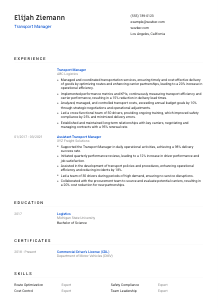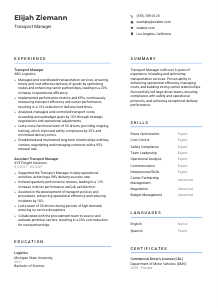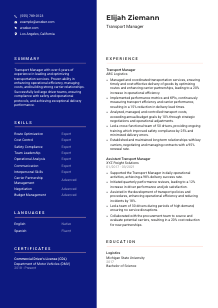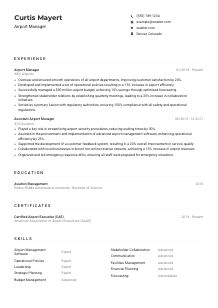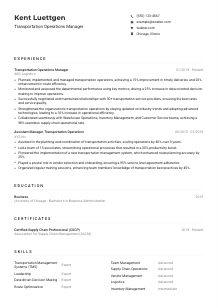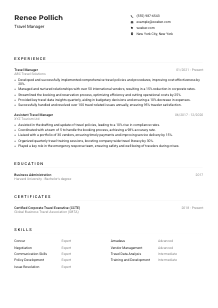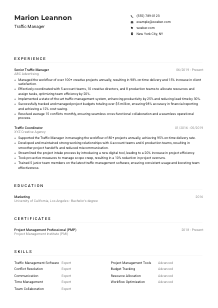Transport Manager CV Example
Steering fleets, but your CV seems stuck in traffic? Accelerate with this Transport Manager CV example, streamlined using Wozber free CV builder. See how effortlessly you can merge your logistical leadership with job outlines, paving a career path as smooth as a clear highway!
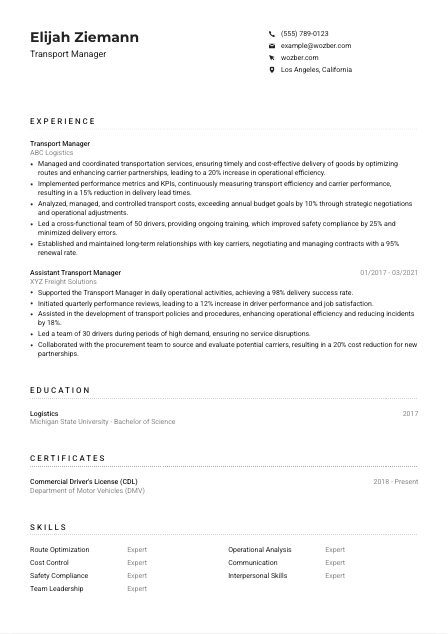
How to write a Transport Manager CV?
Hello, aspiring Transport Manager! In the world of logistics and transport, where precision, efficiency, and leadership take the front seat, your CV is the vehicle that drives you to your career destination. Here, we'll navigate through crafting a CV with Wozber: a free CV builder that ensures your journey from job seeker to job finder is as smooth as the operations you're skilled in managing. Let's fasten our seatbelts and embark on this route to create a CV that not only meets the job specifications but also passes through the ATS filter with ease.
Personal Details
The journey to an exceptional Transport Manager CV begins with your personal details. This section is straightforward yet crucial, serving as the front license plate of your professional vehicle. It should succinctly present who you are in a way that aligns with the Transport Manager role you're aiming for. Here's how to ensure your personal details accelerate interest right from the start.
1. Brand Yourself with Your Name
Your name is the brand logo on your CV vehicle. Position it boldly at the top. Opt for a clear, professional font that's easy to read, akin to ensuring your fleet's branding is visible and identifiable from a distance.
2. Align Your Title
Just as a truck's model and capabilities are clear at a glance, include your current title or the one you're pursuing - in this case, "Transport Manager". Position it prominently to help instantly clarify your professional direction.
3. Ensure Your Contact Details Deliver
Your contact information is your GPS coordinates. They must be accurate and functional. Ensure you include a professional email address and a phone number, formatted for easy dialing. Like making sure your fleet is equipped with reliable navigation, this detail ensures recruiters can easily reach you.
4. Location, Location, Location
For a Transport Manager, understanding the terrain is crucial. By explicitly stating "Los Angeles, California", as in the CV example, you immediately show compatibility with the role's geographic requirements. Consider this akin to ensuring your fleet is ready and optimised for the routes they'll service.
5. Digital Footprint
In the logistics world, tracking is vital. Likewise, include a LinkedIn profile or professional website if relevant, ensuring it mirrors the professionalism of your CV. This acts like a tracking system, offering deeper insights into your career journey for prospective employers.
Takeaway
Your personal details section is like the dashboard of your professional vehicle. It should be neatly organized, providing essential information at a glance, and aligned with the Transport Manager role. Keep it professional, precise, and make sure it navigates the recruiter to your most impressive qualifications.





Experience
The core of your Transport Manager CV is your experience section. It's the engine that powers your CV vehicle, demonstrating your history of successfully managing operations, leading teams, and driving efficiency. Let's map out how to construct this section so it effectively showcases your qualifications for the Transport Manager role, as seen through Wozber's free CV builder.
- Managed and coordinated transportation services, ensuring timely and cost‑effective delivery of goods by otimizing routes and enhancing carrier partnerships, leading to a 20% increase in operational efficiency.
- Implemented performance metrics and KPIs, continuously measuring transport efficiency and carrier performance, resulting in a 15% reduction in delivery lead times.
- Analyzed, managed, and controlled transport costs, exceeding annual budget goals by 10% through strategic negotiations and operational adjustments.
- Led a cross‑functional team of 50 drivers, providing ongoing training, which improved safety compliance by 25% and minimized delivery errors.
- Established and maintained long‑term relationships with key carriers, negotiating and managing contracts with a 95% renewal rate.
- Supported the Transport Manager in daily operational activities, achieving a 98% delivery success rate.
- Initiated quarterly performance reviews, leading to a 12% increase in driver performance and job satisfaction.
- Assisted in the development of transport policies and procedures, enhancing operational efficiency and reducing incidents by 18%.
- Led a team of 30 drivers during periods of high demand, ensuring no service disruptions.
- Collaborated with the procurement team to source and evaluate potential carriers, resulting in a 20% cost reduction for new partnerships.
1. Analyze the Route
Begin by dissecting the job description. Highlight keywords and responsibilities that match your own experiences. For instance, phrases like "ensuring timely and cost-effective delivery" and "analyzing, managing, and controlling transport costs" should be waypoints in your experience narrative.
2. Plan Your Journey
List your roles in reverse chronological order. Clearly display your job title, company name, and the period you were employed. This provides recruiters with a clear roadmap of your professional journey, pointing them directly to your achievements and growth.
3. Highlight Milestones
For each role, articulate your accomplishments in a way that correlates with the job requirements. Use action verbs and quantify your successes. For instance, "Led a team of 50 drivers, reducing delivery errors by 25%" showcases leadership and operational improvements.
4. Showcase Your Impact
Incorporate metrics and numbers when detailing your achievements. This provides tangible evidence of your impact, similar to how logistics relies on data to gauge performance. Whether it's cost savings or efficiency improvements, make your contributions quantifiable.
5. Relate and Relevance
Focus on experience that's directly relevant to the Transport Manager role. This doesn't mean omitting past roles but rather emphasizing the aspects most aligned with transport management, such as route optimisation, safety compliance, and team leadership.
Takeaway
Consider your experience section the detailed logistics report of your career. It should compactly convey where you've been, how you've excelled, and why you're the best candidate for the Transport Manager position. Tailor your journey with precision, ensuring each bullet point drives home your suitability for the role.
Education
In the fleet of your CV, the Education section might seem like the standard equipment, but it's essential for proving you have the theoretical grounding to manage the logistical challenges of transport management. Here's how to navigate this section to ensure it underlines your qualifications for a Transport Manager position.
1. Identify the Essential Qualifications
Begin by matching your education with the role's requirements. The job description calls for a "Bachelor's degree in Logistics, Supply Chain Management, or a related field." Ensure your degree is front and center, just like ensuring your fleet meets the regulatory standards for the road.
2. Display Clearly
Structure your education details in a straightforward manner: degree, field of study, and institution, followed by your graduation date. This clarity ensures that your educational qualifications are easily navigable at a quick glance.
3. Customize Your Degree Details
If your degree directly aligns with the job specifications, as with a "Bachelor of Science in Logistics," highlight it. This establishes a clear link between your academic foundation and the professional expertise the role requires.
4. Mention Relevant Courses
Though not always necessary, pointing out key courses can add depth to your qualifications, especially if they're closely related to transport management. Think of it as the optional but highly effective equipment you can add to your fleet to enhance performance.
5. Highlight Additional Achievements
If there are academic honors or extracurricular involvements that reflect your leadership or logistics capabilities, include them. This can be particularly impactful early in your career, adding another layer of depth to your professional profile.
Takeaway
Your education section substantiates your theoretical knowledge and specialized training in logistics and transport management. Ensure it's structured to communicate not just your qualifications, but your readiness to take on the Transport Manager role with confidence.
Certificates
In the logistics industry, continuous education and certification can set you apart as a Transport Manager. This section is like the safety certifications on your fleet—proof that you're equipped to meet and exceed industry standards. Here's how to spotlight your certifications appropriately.
1. Match Job Requisites
Start by noting the specific certifications listed in the job description. The requirement for a "Commercial Driver's License (CDL)" is a perfect example. Listing this certification demonstrates your alignment with the role's prerequisites and your commitment to the field.
2. Select Pertinent Certificates
While it might be tempting to list every certificate you've ever earned, focus on those most relevant to transport management. This ensures that recruiters immediately see the qualifications that make you a standout candidate for the role.
3. Date Details
Include the acquisition or expiration dates of your certifications where relevant, especially for certifications like the CDL that have renewals. This provides hiring managers with a sense of your current qualifications and dedication to maintaining them.
4. Seek Evergreen Learning
The transport and logistics industry is ever-evolving, and so should your certifications. Regularly updating your qualifications and seeking out new learning opportunities underscores your commitment to staying at the forefront of industry standards.
Takeaway
Your certificates section is a testament to your ongoing commitment to professional development in the field of transport management. Like maintaining your fleet's readiness and compliance, keeping this section updated is crucial for showcasing your qualifications and dedication to excellence.
Skills
The Skills segment of your CV is the dashboard that displays your professional competencies. For a Transport Manager, it's essential to exhibit a blend of strategic planning, operational efficiency, and people management. Here's how to fine-tune this section to reflect your expertise.
1. Study the Map
Thoroughly examine the job requirements and highlight the skills that are directly mentioned or implied. Skills such as "Route Optimisation," "Cost Control," and "Safety Compliance" should be at the forefront, demonstrating your alignment with the role's needs.
2. Prioritize Key Skills
Focus on listing the skills that most closely match the job description. This targeted approach ensures that your CV resonates with the hiring manager and passes the ATS with flying colors.
3. Organize and Streamline
While listing every skill might seem beneficial, it's more effective to concentrate on those that best demonstrate your fit for the Transport Manager role. Use clear, concise language to present your skills, much like how clear signage helps in efficient transport logistics.
Takeaway
Your Skills section is a concise exhibit of your professional toolkit, tailored to meet the demands of a Transport Manager role. Highlight your capabilities with clarity and focus, ensuring they align with what the position needs. Just like in logistics, precision, and clarity keep operations smooth and efficient.
Languages
In our globalized world, the ability to communicate across linguistic barriers can be a significant asset, especially in logistics and transport management. Whether dealing with international carriers or multicultural teams, language skills can drive your CV further. Here's how to accentuate this section.
1. Evaluate Job Specifications
First, check whether the job posting specifies any language requirements. The need for "Competence in both spoken and written English" is a sign that your proficiency in English should be prominently featured, reflecting your ability to meet this essential requirement.
2. List Relevant Languages
If English is a requirement, place it at the top. Then, list any additional languages you're proficient in. This showcases your potential to navigate multicultural environments, adding value to your role as a Transport Manager.
3. Detail Your Proficiency
Clearly indicate your level of proficiency for each language. Use terms like 'Native', 'Fluent', 'Intermediate', or 'Basic' to provide a clear understanding of your skill level, much like the detail you'd give to specifying the capacities and specialties of your fleet.
4. Reflect on the Role's Scope
Consider whether the role involves regional or global operations. If so, showcasing your multilingual capabilities can be particularly advantageous, demonstrating your readiness to handle international communication challenges.
5. Honesty is the Best Policy
Be realistic about your language proficiencies. Overstating your abilities can lead to awkward situations, akin to promising delivery capabilities your fleet can't meet. Transparency is key to building trust, in both logistics and your CV.
Takeaway
Your language skills represent more than just your ability to speak different tongues; they embody your capability to connect and navigate in a diverse, global industry. Whether you're directing international shipments or leading a multicultural team, let your linguistic abilities showcase your readiness for the role. Think of them as your international license, opening roads and opportunities worldwide.
Summary
The Summary is like the welcome sign at the entrance of a logistics hub—it gives a snapshot of what's to come. Crafting an engaging summary is crucial for hooking the reader's attention and positioning you as the ideal candidate for the Transport Manager role. Here's how to ensure your summary is not only compelling but completely aligned with your target position.
1. Set the Destination
Begin with an overview of your professional background. Mention your years of experience in transport and logistics, demonstrating your extensive journey through the industry.
2. Plot the Course
Highlight some of your key skills and achievements that directly respond to the job requirements. For example, elaborate on your track record in "otimizing transport operations" and your leadership in "ensuring compliance with safety regulations."
3. Ensure a Smooth Ride
Keep your summary concise yet loaded with relevant information. Aim for 3-5 impactful lines—think of this as your elevator pitch, drawing the hiring manager into wanting to learn more about you and your professional journey.
4. Add a Personal Touch
Infuse your summary with a bit of your professional personality. Whether it's your commitment to operational excellence or your knack for driving efficiency, let your unique strengths shine through.
Takeaway
Your Summary section acts as the door to your professional world, enticing hiring managers to delve deeper into your CV. It's a snapshot of your career, crafted to highlight your suitability for the Transport Manager role. Just like in logistics, where the first impression matters for efficiency and reliability, your summary sets the tone for your entire CV. Make it count.
Launching Your Transport Manager Journey
Congratulations on fine-tuning your CV into a vehicle ready to take you to your next career destination. Armed with insights from Wozber's free CV builder, including ATS-friendly CV templates and an ATS CV scanner, you're now better equipped to navigate the competitive landscape of Transport Management. Remember, your CV is your personal logistics operation—designed to deliver your profile to the right destination at the right time.
The road ahead is open, and your journey is just beginning. Let's drive your career forward!

- Bachelor's degree in Logistics, Supply Chain Management, or a related field.
- Minimum of 5 years of experience in transport management or related field.
- Proven track record in optimizing transport operations to achieve cost savings and operational efficiency.
- Strong communication, leadership, and interpersonal skills.
- Possession of a valid Commercial Driver's License (CDL) with appropriate endorsements, if necessary.
- Competence in both spoken and written English is essential.
- Must be located in or willing to relocate to Los Angeles, California.
- Manage and coordinate transportation services, ensuring timely and cost-effective delivery of goods.
- Implement performance metrics and KPIs for measuring transport efficiency and carrier performance.
- Analyze, manage, and control transport costs, ensuring the budget is maintained.
- Lead and train a team of drivers, ensuring compliance with safety regulations and best practices.
- Establish and maintain relationships with carriers, negotiate contracts, and manage ongoing partnerships.





